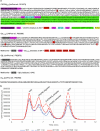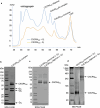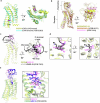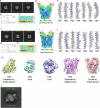Structural insights into CXCR4 modulation and oligomerization
- PMID: 39313635
- PMCID: PMC11832422
- DOI: 10.1038/s41594-024-01397-1
Structural insights into CXCR4 modulation and oligomerization
Abstract
Activation of the chemokine receptor CXCR4 by its chemokine ligand CXCL12 regulates diverse cellular processes. Previously reported crystal structures of CXCR4 revealed the architecture of an inactive, homodimeric receptor. However, many structural aspects of CXCR4 remain poorly understood. Here, we use cryo-electron microscopy to investigate various modes of human CXCR4 regulation. CXCL12 activates CXCR4 by inserting its N terminus deep into the CXCR4 orthosteric pocket. The binding of US Food and Drug Administration-approved antagonist AMD3100 is stabilized by electrostatic interactions with acidic residues in the seven-transmembrane-helix bundle. A potent antibody blocker, REGN7663, binds across the extracellular face of CXCR4 and inserts its complementarity-determining region H3 loop into the orthosteric pocket. Trimeric and tetrameric structures of CXCR4 reveal modes of G-protein-coupled receptor oligomerization. We show that CXCR4 adopts distinct subunit conformations in trimeric and tetrameric assemblies, highlighting how oligomerization could allosterically regulate chemokine receptor function.
© 2024. The Author(s).
Conflict of interest statement
Competing interests: All authors are employees of Regeneron Pharmaceuticals and may own stock and/or stock options of the company. W.C.O. is an officer of Regeneron. All funding for this work was provided by Regeneron Pharmaceuticals. The anti-CXCR4 antibody described in this manuscript is a subject of international patent applications (PCT/US2024/044209 and PCT/US2024/044111).
Figures
















Similar articles
-
Structural mechanisms underlying the modulation of CXCR4 by diverse small-molecule antagonists.Proc Natl Acad Sci U S A. 2025 Mar 18;122(11):e2425795122. doi: 10.1073/pnas.2425795122. Epub 2025 Mar 10. Proc Natl Acad Sci U S A. 2025. PMID: 40063796 Free PMC article.
-
Chemokine receptor CXCR4 oligomerization is disrupted selectively by the antagonist ligand IT1t.J Biol Chem. 2021 Jan-Jun;296:100139. doi: 10.1074/jbc.RA120.016612. Epub 2020 Dec 6. J Biol Chem. 2021. PMID: 33268380 Free PMC article.
-
Differential activity and selectivity of N-terminal modified CXCL12 chemokines at the CXCR4 and ACKR3 receptors.J Leukoc Biol. 2020 Jun;107(6):1123-1135. doi: 10.1002/JLB.2MA0320-383RR. Epub 2020 May 6. J Leukoc Biol. 2020. PMID: 32374043 Free PMC article.
-
Modulators of CXCR4 and CXCR7/ACKR3 Function.Mol Pharmacol. 2019 Dec;96(6):737-752. doi: 10.1124/mol.119.117663. Epub 2019 Sep 23. Mol Pharmacol. 2019. PMID: 31548340 Review.
-
The good and bad faces of the CXCR4 chemokine receptor.Int J Biochem Cell Biol. 2018 Feb;95:121-131. doi: 10.1016/j.biocel.2017.12.018. Epub 2017 Dec 27. Int J Biochem Cell Biol. 2018. PMID: 29288743 Review.
Cited by
-
Structural mechanisms underlying the modulation of CXCR4 by diverse small-molecule antagonists.Proc Natl Acad Sci U S A. 2025 Mar 18;122(11):e2425795122. doi: 10.1073/pnas.2425795122. Epub 2025 Mar 10. Proc Natl Acad Sci U S A. 2025. PMID: 40063796 Free PMC article.
-
CXCR3 inhibitors for therapeutic interventions: current status and perspectives.Front Pharmacol. 2025 Jul 25;16:1556196. doi: 10.3389/fphar.2025.1556196. eCollection 2025. Front Pharmacol. 2025. PMID: 40786052 Free PMC article. Review.
-
MSA clustering enhances AF-Multimer's ability to predict conformational landscapes of protein-protein interactions.Bioinform Adv. 2024 Dec 6;5(1):vbae197. doi: 10.1093/bioadv/vbae197. eCollection 2025. Bioinform Adv. 2024. PMID: 39735576 Free PMC article.
-
Unraveling the therapeutic landscape of approved non-peptide macrocycles.Acta Pharm Sin B. 2025 Jul;15(7):3436-3459. doi: 10.1016/j.apsb.2025.04.021. Epub 2025 Apr 25. Acta Pharm Sin B. 2025. PMID: 40698129 Free PMC article. Review.
-
Molecular contacts in self-assembling clusters of membrane proteins.Proc Natl Acad Sci U S A. 2025 Jul;122(26):e2507112122. doi: 10.1073/pnas.2507112122. Epub 2025 Jun 23. Proc Natl Acad Sci U S A. 2025. PMID: 40549920 Free PMC article.
References
-
- Britton, C., Poznansky, M. C. & Reeves, P. Polyfunctionality of the CXCR4/CXCL12 axis in health and disease: implications for therapeutic interventions in cancer and immune-mediated diseases. FASEB J.35, e21260 (2021). - PubMed
-
- Guo, F. et al. CXCL12/CXCR4: a symbiotic bridge linking cancer cells and their stromal neighbors in oncogenic communication networks. Oncogene35, 816–826 (2016). - PubMed
-
- Feng, Y., Broder, C. C., Kennedy, P. E. & Berger, E. A. HIV-1 entry cofactor: functional cDNA cloning of a seven-transmembrane, G protein-coupled receptor. Science272, 872–877 (1996). - PubMed
MeSH terms
Substances
LinkOut - more resources
Full Text Sources

